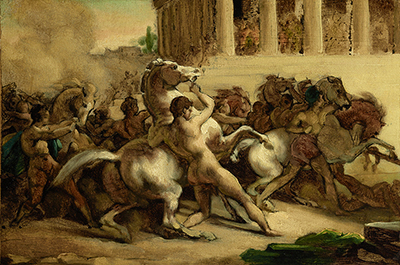Ever since he was a boy, French artist Theodore Géricault loved horses and used them as subjects for his paintings. The Race of the Riderless Horses is one of the pieces attributed to this passion. In 1817, Géricault was in Rome and while there, he visited the Roman Carnival.
The artist conducted various studies to come up with the artwork. It was supposed to be for an exhibition at the Salon. However, Géricault did not get to complete it because he was called back to France. Therefore, it was never clear which of the studies he would use for the final piece. In this artwork, Géricault captured the scene just before the start of the race.
The Horses and Their Grooms
In this version of The Race of the Riderless Horses, the artist presents the animals in mid-flight. They are running around eager to get in the race. The horses are in a frenzy, and a cloud of dust is visible amidst the stampede. Grooms are running around trying to get the horses in control. Some are succeeding while others are on the ground, overpowered by their animals. Several of the men are in loincloths, but the central figure is nude. He is working to pull a large white horse to a standstill. A structure in ancient Roman architecture occupies most of the background. Several horses are visible between the columns of the building.
A Richly-inspired Style
Géricault chose monochromatic tones for this painting. The shades of whites, light browns and grey set a serious but powerful scene. By using thick swirls, the artist presents the strengths of the naked man. He highlights the character's bulging biceps, toned back and massive thigh muscles. Géricault does the same for the horse. It comes across as an enormous beast that is hard to control. The painter adds a bit of bright colour in the foreground with a patch of grass. During his time in Rome, Géricault grew fascinated with Baroque art and Michelangelo. His passion for the style is visible in the use of monochrome themes. Géricault had a unique gift for presenting the animal form, a skill he acquired from French painter Carle Vernet while learning about English sporting art.
Additionally, he had experience with classicist figure composition and construction, which manifests in every contour of horses in this painting. The French artist uses light and shadows in the piece in a way that give it a real-life appearance. It's easy to envision the horses stomping around, out of control. Besides the realism of the artwork, Géricault mythologised the annual Roman event. The nude groom represents an athlete in ancient Greece hence, the muscular physique. He recalls the Parthenon, a frieze by Phidias through the large, thrusting animals.




